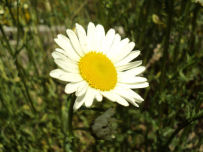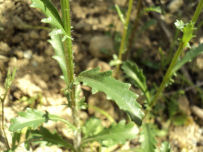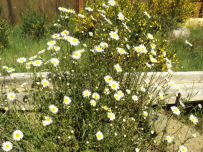|
|
|
|
|
|
| Practical ecological knowledge for the temperate reader. |
Oxeye Daisy - Leucanthemum vulgare
- Family: Asteraceae - (Aster) [E-flora]
Description
Synonyms
- Chrysanthemum leucanthemum L. [PFAF]
- Chrysanthemum leucanthemum var. boecheri B. Boivin [PFAF]
- Chrysanthemum leucanthemum var. pinnatifidum Lecoq & Lamotte [PFAF]
- Leucanthemum leucanthemum (L.) Rydb. [PFAF]
- Leucanthemum vulgare var. pinnatifidum (Lecoq & Lamotte) Moldenke [PFAF]
"Leucanthemum vulgare is a PERENNIAL growing to 0.6 m (2ft) at a medium rate..
It is hardy to zone (UK) 3 and is not frost tender. It is in flower from Jun to August. The flowers are hermaphrodite (have both male and female organs) and are pollinated by Bees, flies, beetles, lepidoptera, self.The plant is self-fertile..
Suitable for: light (sandy), medium (loamy) and heavy (clay) soils and prefers well-drained soil. Suitable pH: neutral and basic (alkaline) soils. It cannot grow in the shade. It prefers moist soil. The plant can tolerates strong winds but not maritime exposure."[PFAF]
General: Perennial herb from a creeping rhizome; stems erect, solitary to several, sparingly branched, usually glabrous, with a sage-like odour, 20-80 cm tall. [IFBC-E-flora]
Leaves: Basal leaves alternate, egg-shaped to spoon-shaped, stalked, pinnately lobed or toothed, 4-15 cm long; stem leaves reduced and becoming unstalked and nearly entire upwards. [IFBC-E-flora]
Flowers: Heads with ray and disk flowers, solitary at the ends of branches; involucres 7-11 mm tall; involucral bracts narrowly lanceolate, with a narrow, dark-brown submarginal area; ray flowers white, 12-20 mm long; disk flowers yellow. [IFBC-E-flora]
Fruits: Achenes cylindric or nearly so, black, 10-ribbed; pappus lacking. [IFBC-E-flora]
Habitat / Range: Mesic to dry roadsides, pastures and waste places in the lowland, steppe and montane zones; common throughout BC S of 56degreeN; introduced from Eurasia. [IFBC-E-flora]
Status: Exotic [E-flora]
Hazards
- Allergenic [HMH Duke]
- Large doses emetic (WO2) [HMH Duke]
Food
- Flowers:
- "Flower heads used like dandelion in home wine making." [EMNMPV.7]
- Shoots
- Finely chopped young spring shoots can also be added to salads, as can the root. The unopened buds can be marinated and used like capers as a condiment. [Tilford]
- Leaves
- Leaves can be eaten raw when young. It has a rather pungent taste, so they should be consumed sparingly or added to mixed green salads. [Tilford]
- “...the leaves of this plant are among the most palatable fresh wild greens available. The young basal leaves are best and have a sweet flavor with a texture much like romaine lettuce; gourmet restaurants sometimes serve them in salads.” [Gardenweed]
- "The leaves in the spring are one of the best edibles available.... The flavour is reminiscent of green apples and sage with a sweet aftertaste." [Jones TDFB]
- Root
- “The rootstalks of the ox-eye daisy were reportedly eaten as a potherb in spain.” [Gardenweed] Root - raw[5]. Used in spring[207].[PFAF]
Other Uses
- Dye
- "Ray florets contain glycoside apiin which yields the coloring mater apigenin.... The plant is cultivated on commercial scale in peninsular India, particularly around Coimbatore, Dharmapuri, Madurai, Bangalore, and Ahmad Nagar." [Singh HNDP]
- Insecticide
- “The preparations of the flowers are fairly useful insecticides, as the flowers contain pyrethrins.... The powder can be fluffed into the fur of pets for repelling fleas”. [Tiford]
- Preparation: As an insecticide, Fresh Flower Tincture, 1:2, add 1 tablespoon dish detergent per cup of finished tincture for spraying; as a powder; the recently dried flowers, ground in a blender, then stored in a closed container in the freezer.” [MPPW]
Medicinal Uses
"Oxeye Daisy decreases secretions when taken internally, and dries up and disinfects when applied externally. It is usually best when taken warm (not hot) or simply at room temperature. Use it for bronchitis or asthma characterized by moist, hypersecreting mucosa, with copious watery secretions, and red, inflamed membranes. It has some of the anti-inflammatory effects found in its relative Feverfew, although not enough to induce possible side effects." [MPPW] Menomini Indians used it for fevers (H H Smith. 1923). [DPL Watts] The whole plant, and especially the flowers[7], is antispasmodic, antitussive, diaphoretic, diuretic, emmenagogue, tonic and vulnerary[4, 7, 21]. It is harvested in May and June then dried for later use[4]."[PFAF]
- Dosages (Oxeye Daisy) — 1 cup 3 ×/day (PH2).
- Juice: "In the Highlands, the juice boiled with honey was used for coughs, and the same preparation was applied to wounds..." [DPL Watts] "In Ireland the boiled juice has similarly been applied for coughs, more especially tubercular ones.... sore eyes were also bathed with the cooled boiled juice. " [MPFT]
- Tea: the plant was sometimes made into a tea to treat asthma. [DPL Watts] "
- Externally: in Russia, it was used as a household remedy for external haemorrhages [DPL Watts] "Externally it is used as a lotion on bruises, wounds, ulcers and some cutaneous diseases[4, 7]. A decoction of the dried flowers and stems has been used as a wash for chapped hands[257]." [PFAF]
- Herb
- Jaundice: “A decoction of the whole herb in ale was used by rural Americans as a folk remedy for jaundice.” [Tilford]
- Flowers
- Tea: The tea is a good douche, mixed with California Bayberry, or Hedge Nettle for an astringent.”It is antifungal and antibacterial, and besides being a useful douche, it may be used as a cleansing, disinfecting wash. It can be used as a hair and beard rinse for scalp and skin fungal infections.” [MPPW] "In Tyrone and Monaghan, on the other hand, a tea formerly much drunk there (to ward off a chill) was made from an infusion of the ray florets." [MPFT] "A distilled water made from the flowers is an effective eye lotion in the treatment of conjunctivitis[7]." [PFAF]
- Collecting: "Gather flowering stems and dry them". "The plant is strongest when first flowering (usually mid-June), but it is serviceable up until early September. Discard dead flowers and leaves before drying. Include the stems with the herb." [MPPW]
- Stability: “Oxeye Daisy will stay effective for about a year as the dried herb.” [MPPW]
- Standard Infusion: “2 to 4 fluid ounces, up to three times a day. Dry Herb Tincture (recent herb only), 1:5, 50% alcohol, ½ to 1 teaspoon, up to three times a day." [MPPW]
- Root:
- Nightsweats: “Nightsweats associated with [TB] were treated with a glass of water in which 15-60 drops of the fluid root extract were added. [MPPW]
Ethnobotany
- The whole plant; "An infusion of leucanthemum is tonic and should be considered in cases of colliquative sweating in which it is not desirable to use the active antihydrotics, as atropine, muscarine, or camphoric acid." [Felter EMM]
- Veterinary Use: "There is one veterinary usage, and a very odd one it is. Coughs in cattle were treated at one time by putting a piece of the root in a hole made in the cow’s ear or dewlap (Drury. 1985)."[DPL Watts]
Pharmacology & Phytochemistry
|
Pharmacology
The whole plant, especially the flowers, is;
- Antiinflammatory (1; FAD); [HMH Duke]
- Antipyretic (f; DEM); [HMH Duke]
- Antisecretory (1; WO2); [HMH Duke]
- Antispasmodic (1; FAD; PH2; WO2); [HMH Duke]
- antitussive, [PFAF]
- Collyrium (f; DEM; FAD); [HMH Duke]
- Dermatitigenic (1; WO2); [HMH Duke]
- diaphoretic, [PFAF]
- Diuretic (f; PH2; WO2); [HMH Duke]
- Emetic (1; WO2); [HMH Duke]
- emmenagogue [PFAF]
- Tonic (f; DEM; FAD; PH2; WO2) [HMH Duke]
- vulnerary. [PFAF]
|
Phytochemistry
- parthenolide [HMH Duke]
- artecanin [HMH Duke]
- canin [HMH Duke]
- 3-beta-hydroxyparthenolide [HMH Duke]
- secotanoparthenolide [HMH Duke]
- Platyphylline [Azimova Alkaloids]
- Senecionine [Azimova Alkaloids]
- Choline [Azimova Alkaloids]
- Aerial Part - Essential oil, % on air dry wt: 0.4–0.5 [LLCEOPS]
|
Nutritional
|
Oxeye Daisy – Leucanthemum vulgare [Turner, Kuhnlein]
| Part: | Leaves | Per 100 g fresh weight |
| Water (g) | 77 | Thiamine (mg) | - | Magnesium (mg) | - |
| Protein (g) | - | Riboflavin (mg) | 0.39 | Calcium (mg) | - |
| Carbohydrate (g) | - | Vitamin C (mg) | 29.3 | Sodium (mg) | - |
|
Oxeye Daisy – Leucanthemum vulgare [Turner, Kuhnlein]
| Part: | Leaves (Cooked) | Per 100 g fresh weight |
| Water (g) | 93 | Thiamine (mg) | - | Magnesium (mg) | - |
| Protein (g) | - | Riboflavin (mg) | 0.05 | Calcium (mg) | - |
|
Cultivation
- Blooms: “Blooms first in early summer, then typically remaining in bloom until fall.” [Tilford]
Cultivation in India: For its cultivation, the field is ploughed 3–4 times during June–July and
brought to a fine tilt. About 50 tonnes of farm yard manure is incorporated
per hectare. Beds of 4 × 3 m are formed, and about 2.5 lakh suckers or rooted
cuttings are planted per hectare in April and August. The crop is irrigated once
in 8–10 days but does not tolerate water loggings. The flowers come after 3–4
months of its plantation.[Singh HNDP]
Propagation
Seed - sow spring in a greenhouse. When they are large enough to handle, prick the seedlings out into individual pots and plant them out in the summer. Division in spring or autumn. Larger clumps can be replanted direct into their permanent positions, though it is best to pot up smaller clumps and grow them on in a cold frame until they are rooting well. Plant them out in the spring. Basal cuttings in spring. Harvest the shoots when they are about 10cm long with plenty of underground stem. Pot them up into individual pots and keep them in light shade in a cold frame or greenhouse until they are rooting well. Plant them out in the summer.[PFAF]
"20–40+ species: Europe, northern Africa." [Jepson]
Local Species;
- Leucanthemum vulgare - oxeye daisy [E-flora]
References
- [E-flora] Leucanthemum vulgare, http://linnet.geog.ubc.ca/Atlas/Atlas.aspx?sciname=Leucanthemum%20vulgare&redblue=Both&lifeform=7, Accessed Aug 3, 2016
- [Jepson] Bruce G. Baldwin, adapted from Strother (2006), 2013. Leucanthemum, in Jepson Flora Project (eds.) Jepson eFlora, http://ucjeps.berkeley.edu/cgi-bin/get_IJM.pl?tid=3801, accessed on Jan 4 2015
- [PFAF] Leucanthemum vulgare, http://www.pfaf.org/user/Plant.aspx?LatinName=Leucanthemum+vulgare, Accessed Aug 3, 2016
Page last modified on Monday, January 3, 2022 0:43 AM





